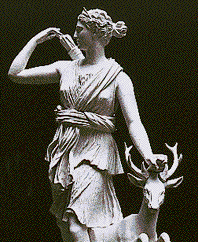
Artemis and Stag
de-ac-ces-sion (v. t.)
To remove and sell (a work of art) from a museum’s collection, especially in order to purchase other works of art.
Webster’s Dictionary
Recently, the Albright-Knox Art Gallery, the principal museum of Buffalo, New York, decided to sell a number of important art works in its permanent collection with the intent of “acquiring and exhibiting art of the present.”
Among the works that will be “traded up” are:
1. Artemis and Stage, a greco-roman statue
2. An ancient Chinese Bronze (there are only a handful in the world)
3 A life-size, Tenth-century statue of the god Shiva, that a Sotheby’s specialist told the Associated Press is “the most important Indian sculpture ever to appear on the market.”
In addition, many paintings by old masters will be auctioned off.
Tom L. Freudenheim, a former Museum Director and a current member of the Association of Art Museum Directors (AAMD), grew up in Buffalo. He wrote an article published in the Wall Street Journal condemning the move by the Art Gallery to sell its collection:
Museums are devoting more and more resources to acquiring large amounts of contemporary art, work about which the judgment of history — supposedly what museums are all about — is far from settled. Such acquisition policies may be acceptable, but not when done by getting rid of masterpieces whose importance has been validated by time and critical opinion and that provide a context for the work of the present. Ironically, this plan is driven by perceptions about the notably erratic and currently inflated contemporary art market, rather than by any dire financial crisis.
He continues:
The message is, once again, that those entrusted with the sacred task of safeguarding our public patrimony have become as irresponsible as the money-grubbing executives who have given corporate America such a bad name. The works of art in the Albright-Knox Art Gallery don’t belong to the directors or curators, who move in and out of communities as job opportunities present themselves. Nor are they the property of the trustees, who are meant to hold them in trust for the people of Buffalo, but who now show that they cannot be trusted.
It’s hard not to agree with Mr. Freudenheim; however, I took a few minutes to visit the Albright-Knox website for their side of the story, and, while they did not offer any information on the upcoming deaccessioning auction, they did have a mission statement that seemed to support their actions:
The Albright-Knox Art Gallery, one of the nation’s oldest public arts organizations, has a clear and compelling mission to acquire, exhibit, and preserve both modern and contemporary art. It focuses especially on contemporary art, with an active commitment to taking a global and multidisciplinary approach to the presentation, interpretation, and collection of the artistic expressions of our times. In an enriching, dynamic, and vibrant environment that embraces diverse cultures and traditions, the Gallery seeks to serve a broad and far-reaching audience.
To validate that this has always been their policy, I used Archive.org’s Way Back Maching to find out whether or not this is a recent mission statement or long-stated goal. Sure enough, this has always been their statement.
The question then becomes, not “why are they selling these priceless items?” but, with an emphasis on contemporary art, “why did they ever acquire these old, priceless pieces in the first place?”
I submit to you that it has always been the mission of the AKAG to collect and exhibit modern and contemporary art. While these magnificant pieces of art were donated to the museaum many, many years ago, they do not support the mission of an institution struggling to remain at the forefront of the exhibition of contemporary art.
When Seymour Knox acquired the great pieces from Pollock, Warhol, Dine, Motherwell and so many others, they were fresh with the smell of paint. There are hundreds and maybe thousands of other paintings amoung the more than 7000 pieces of art owned by the gallery that we will never again see of hear from the artists as Mr. Knox, Mr, Smith and others made decisions that frankly did not turn out as hoped. But, that is the foundation of building a collection and without resources, the Academy will be unable to find more Rothko’s, Peppers, Pollocks and others that will be cherished and enjoyed by future generations of Buffaloians and art lovers.
So, it was with great consideration and care that the Trustee’s made this difficult decision. But it was made I assure you, with the best interests of the insitution and its future as a world class museaum of modern and especially contemporary art.